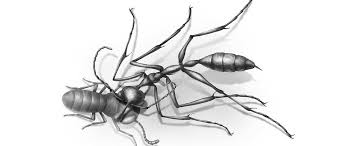Researchers say the only way prey could be captured in this position is for the ant’s mouthparts to move in a direction “unlike that of all living ants”.
Source: Science Focus
A stunning, 99-million-year-old fossil has captured a hell ant in the act of attacking its prey.
It provides rare evidence for how these extinct insects hunted with their scythe-like mandibles and horn-like headgear.
The hell ant belongs to a previously identified species called Ceratomyrmex ellenbergeri. It was preserved in amber found in Myanmar (formerly Burma) along with its insect prey, an extinct relative of the cockroach.
Like other species of hell ant, Ceratomyrmex sports a pair of deadly mandibles that snap upwards in a vertical motion, unlike the mandibles of modern ants, which move horizontally. Also unlike modern ants, the hell ants have horns protruding from their heads.
The new fossil provides direct evidence that hell ants, which are believed to have become extinct along with the dinosaurs some 65 million years ago, used their headgear to hunt, snapping their mandibles to pin their prey against the horn.
The hell ant, belonging to a species called Ceratomyrmex ellenbergeri, and its prey were found in Myanmar preserved in amber © Current Biology/2020 Elsevier Inc/NJIT, Chinese Academy of Sciences and University of Rennes, France
“To see an extinct predator caught in the act of capturing its prey is invaluable,” said study leader Dr Phillip Barden at New Jersey Institute of Technology in the US.
“This fossilised predation confirms our hypothesis for how hell ant mouthparts worked.
“The only way for prey to be captured in such an arrangement is for the ant mouthparts to move up and downward in a direction unlike that of all living ants and nearly all insects.”
Barden’s team thinks that the early ancestors of hell ants would have first gained the ability to move their mouthparts vertically, while the diverse horns evolved later.
Some hell ant species had horns with serrated teeth, while one species is believed to have impaled its victims on a horn that was reinforced with metal.
The team now hopes to find more ancient ant fossils, with the aim of understanding why hell ants went extinct, while their modern-day equivalents thrived.
Source: Science Focus

































Leave a Comment
You must be logged in to post a comment.